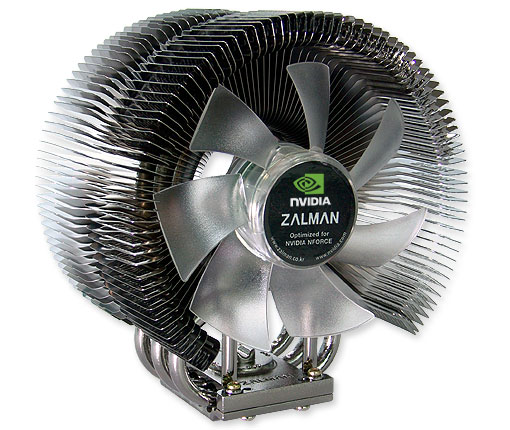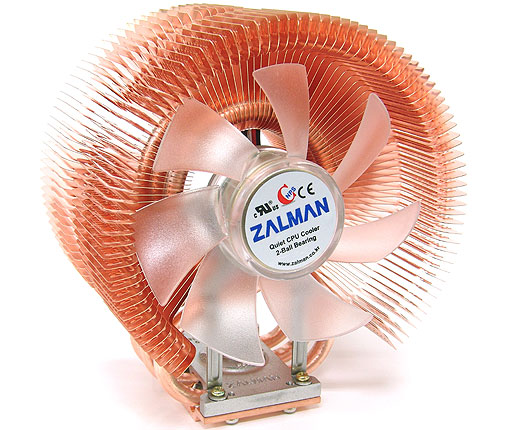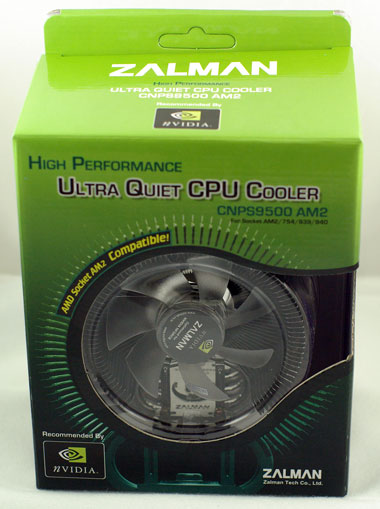The Zalman Twins: 9500 & 9700 Air Tunnels
by Wesley Fink on February 19, 2007 12:40 AM EST- Posted in
- Cases/Cooling/PSUs
Zalman 9500
The Zalman 9500 burst onto the scene with the introduction of the AM2 processor about 9 months ago. It is a cooling product recommended by NVIDIA for use with their chipset motherboards for AMD. As a result the 9500 series is available in two models, the CNPS9500 AM2 and the CNPS9500 LED. The heatsinks and fans are both the same, but the cosmetics and mounting kits are different.
The AM2 version has a coating which makes it look like it is dark nickel plated and the fan has green LEDs to match an AMD color scheme. The AM2 only comes with AM2 mounting hardware and it includes the Fan Mate 2 fan controller. The LED version is the regular copper color with blue LEDs and the mounting hardware for Intel Socket 775, Intel 478, AMD 754, AMD 939, and AMD 940. It does not support AM2, but it also includes the Fan Mate 2.

The 9500 (and larger 9700) feature the Zalman Air Tunnel design, which Zalman claims is optimized for air cooling efficiency. The 9500 fan is a 92mm custom embedded fan, and it is not user interchangeable with other 92mm fans.

Since we have a good collection of Zalman coolers in the lab, it is worth mentioning that the 9500 and 9700 hardware is interchangeable. The base is the same size and socket adapters can be freely used back and forth.
Installation is both easy and very well documented. The instructions are reasonably clear, but most Zalman coolers also include installation videos on their web-site. The installation video for the 9500 LED is available here and it includes tabs for installation on Socket 775, Socket 478, and Socket 754/939/940.

Our test version of the 9500 was for AM2, but the interchangeable installation parts from the 9700 made it very easy to mount the cooler on a Core 2 Duo in Socket 775.

If you plan to mount on a Core 2 Duo then you should buy the CNPS9500 LED, which includes the Socket 775 adapter for mounting. The adapter works as it should, but it is not a particularly precise piece of plastic. We had to push and prod the back plate to get the embedded nuts on the back plate to align with the holes on the 680i motherboard. In fairness that was the only thing difficult about mounting the Zalman 9500; everything else was very straightforward. The fan uses a 3-pin connector, which is basically not adjustable, but Zalman includes the excellent Fan Mate 2 adapter which provides variable fan speed to any standard fan.
Fan Mate 2
Like most of the top Zalman coolers, the 9500 series comes packaged with the excellent Fan Mate 2 fan controller. This useful little gadget allows speed control of any fan that can attach to a 3-pin fan header, by adjusting voltage on the 12V line. In future reviews we will use the Fan Mate to more conveniently measure noise at both low speed and high speed fan settings.
| Fan Mate 2 Specifications | |
| Dimensions | 70(L) x 26(W) x 26(H)mm |
| Weight | 20g |
| Output Voltage | 5V ~ 11V +/- 2% |
| Allowable Power | 6W or lower |
| Connector | 3-Pin |
Specifications
Our test system is Intel Socket 775, but the Zalman CNPS9500 LED will mount on a wide range of systems with various CPU sockets. All the needed hardware is included to fit the variety of supported sockets. The only current socket not supported is AM2. If you are planning to mount on an AM2 motherboard you will need the CNPS9500 AM2.
| Zalman CNPS9500 LED Specifications | |
| Heatsink | |
| Dimensions | 85(L) X 112(W) X 125(H)mm |
| Weight | 530g (including fan) |
| Material | Pure Copper |
| Dissipation Area | 3,698cm2 |
| Thermal Resistance - Silent Mode | 0.16 C/W |
| Thermal Resistance - Low-noise Mode | 0.12 C/W |
| Fan | |
| Fan Size | 92 mm |
| Bearing Type | 2-Ball Bearing |
| Speed - Silent Mode | 1,350rpm +/- 10% |
| Speed - Low-noise Mode | 2,600rpmM +/- 10% |
| Noise Level - Silent Mode | 18.0dB +/- 10% |
| Noise Level - Low-noise Mode | 27.5dB +/- 10% |
The 9500 is tall and wide, but it was designed to clear components on most motherboards. We had no trouble mounting the 9500 on several high-end boards we had available in the lab. At 530g, the 9500 is a lot lighter than the two-pound heatpipe towers we have tested. It is a bit heavier than recommended by AMD and Intel, but the added reinforcement from the mounting method should make the 9500 a relatively safe install on most motherboards.










50 Comments
View All Comments
Scorpion - Wednesday, February 21, 2007 - link
Page 5 states:So for 30 minutes, you capture 450 data points. It's expected that the data will ramp up over the 30 minute interval and reach an approximately linear stability region towards the end.
I have a problem with your measurement evaluation and findings. I do not think this is a very conclusive or accurate measurement and evaluation criteria. This information could be useful, yes, but only as an additional evaluation criteria.
All tests need a good, quantifiable evaluation metric. The "goodness" of a test is only as good as that metric. And I conclude that what you've chosen is a poor metric. Your posterior evaluation is highly influenced by noise. The maximum could be the result of a large noise addition to the measurement.
A better choice would have been to analyze the data results from all the tests to determine a stability region in the latter part of the data measurements, for all tests. Treat the data in that region as a random variable and take the expectation over that region. That would give you a much better evaluation criteria. You could also compute the variance of the data in this region to determine how stable the performance is for each cooler. This could also be a useful metric, although I know that this may not mean much to your typical audience. Another interesting metric would be to evaluate the other region in the data, in order to measure how quickly temperature ramps up. Or put into other words, how quickly each fan responds to temperature changes.
I'm saddened to see a good and useful article brought down by it's poor evaluation criteria. It effectively reduces the confidence in your conclusions.
Wesley Fink - Friday, February 23, 2007 - link
We try to answer two questions in our cooling tests. First, most users beef up cooling to improve overclocking. We determine the highests stable overclock using a standard CPU/test bed by finding the overclock the cooler can maintain for 30 minutes of looping a demanding game. The highest OC is a very good measure of the effectivenes of the cooler and is compared to other coolers. We also measue and report the highest temperature in this load condition - and yes it does spike up and level off as you suggest. We haven't seen the huge spikes you might fear are there in our test data. Temps rise quickly and stabilize at the temp we report. This is a good indication of cooler efficiency.Second, some users beef up cooling to reduce noise. We also report the lowest noise measurements for the cooler we are testing.
Your suggestions would provide much useful information, and we may add additional testing in the future. However, for now, we are trying to cut through all the hype surrounding cooler testing and provide as much useful info to our readers as possible in a timely manner. We are comfortable that we answer the two questions above in our cooler reviews, and those are the main questions our readers are always asking us about cooler performance.
cyberkost - Tuesday, February 20, 2007 - link
I did not quite get the methodology of the noise level comparisons...Were the coolers required to provide "same cooling performance" (e.g., same CPU temperature some long time into running some stress test)? It does not seem that they were. I'm worried about Anandtech intending to adapt the noise-comparison technique described in this article. The proper technique (IMHO) would be:
1) install cooler
2) run a stress test
3) dial cooler RPM till a (judiciously) chosen (same for all coolers) CPU temperature is achieved (say 40C) in a stable manner
4) record the noice level and put it on the comparison chart
strikeback03 - Tuesday, February 20, 2007 - link
Reading the respective reviews, it would appear that at stock speeds (and possibly some others) that the Katana, for example, does not get as cool as the Tuniq even when the Katana is at max RPM and the Tuniq at minimum.rjm55 - Tuesday, February 20, 2007 - link
Can you please review the Austrian Noctua NH-U12. I've seen good and bad reviews and I want to see what you find.gloutch - Tuesday, February 20, 2007 - link
The performance of those headpipes coolers is reduced if not properly oriented.SO: What was the position of the Zalmann coolers during the test ????????????????????
Wesley Fink - Tuesday, February 20, 2007 - link
From page 4 - CPU Cooling Test Configuration:"All cooling tests are run with the components mounted in a standard mid-tower case. The idle and stress temperature tests are run with the case closed and standing as it would in most home setups. We do not use auxiliary fans in the test cooling case, except for the north bridge fan attached to the 680i for overclocking."
As an aside we have found the impact of heatpipe cooler orientation to be pretty small - we just don't leave that test criteria to chance. An article on the impact of heatpipe cooler orientation on performance could be interesting.
orion23 - Monday, February 19, 2007 - link
Hi!Thanks for this awesome review. Only 2 top coolers left to review:
Thermalright Ultra 120
Scythe Infinity!
It is great to see Anandtech starting to review other PC components such as CPU Coolers and RAM. Things can be very quiet around here unless a new CPU, GPU or MotherBoard comes along......
Hopefully this is only the beginning of a new Anandtech that will review other important PC components such as the PSU, CPU Coolers, (AIR / Water), Fan Controllers...
It wouldn't hurt to have more stuff to read around here!
DrMrLordX - Tuesday, February 20, 2007 - link
Actually, the SI-128 and Noctua NH-U12F probably deserve a review at some point as well. Maybe even the Scythe Mine? The Mine can supposedly outperform the Ninja when using high-cfm fans, but your guess is as good as mine when it comes to actually mounting a 120mm fan on the Mine that normally takes a 100mm fan.DrMrLordX - Tuesday, February 20, 2007 - link
Woops, I forgot the Big Typhoon and Big Typhoon VX.